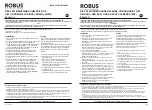
VON MODEL SST15-832 ARC REFLECTION SECTIONALIZING SYSTEM Page 8
3.
Turn the unit ON.
4.
Identify the far end of the cable under test. When the unit is turned on, it will
automatically attempt to mark the far end of the cable. Always look at the trace to see
if you agree with the software. If the Autorange software fails the unit will go to the
default range (normally the 1500 feet/500 meters). Increase the range until the
upward blip typical of the open end is seen on the display. The relative size of the blip
depends on the length of the cable and how much pulse energy is absorbed by the
cable. To increase the range: first push the Range button, then press the up Arrow
button. If the you pass the range that puts the cable end closest to the right side of
the display, push the “DOWN” arrow button until the desired range is selected. As the
ranges get longer the amplification normally needs to be increased with the GAIN
button.
If a downward deflection is seen instead of an upward deflection, either the end of the
cable is shorted or there is a grounded fault in the cable.
To verify that a given upward blip is the cable end, alternately ground and open the far
end while observing the display. The end blip will be downward when the end is
grounded and upward when it is open.
Normally the far end has a distinctive up blip and is the highest up indication on the
waveform. If the cable has a fault with low resistance (less than 200 ohms at 10 volts)
a down blip will appear at the fault. The far end of the cable will not show past such a
low resistance fault.
5.
The maximum voltage can be adjusted using the VOLTAGE ADJUSTMENT knob. It
is recommended that except on 5kV and below cable, the VOLTAGE ADJUSTMENT
be kept at or near maximum, as the transformers in the loop dissipate much of the
energy. With the entire section on the display, push the
START
button until the
sentence “WAITING FOR THUMPER” appears on the top of the display and the
thumper will start charging up to the selected voltage. When the gap fires, the ARC
REFLECTION SEQUENCE should begin in the radar and a new trace made during
the arc will appear at the bottom.
6.
On loops with transformers connected the sound inside the unit is the same for a good
cable and a faulted cable. If the radar pulse that was sent out by the trigger circuit
arrived a the fault while it was arcing over to ground the top memory will contain the
trace of the cable showing a low impedance down blip at the fault. If both displays are
the same then there is no apparent fault. Two approaches are available if the radar
does not still indicate the fault.
7.
After pulsing the cable, the bottom trace will be identical to the top trace until the
location of the fault. At that point the bottom trace will diverge and change shape from
the top reference trace. The first left hand point at which the two traces diverge is the
fault. (After the divergence the two cable waveforms do not match up) Units with
Autolocate software will attempt to automatically mark this point. If autolocate fails
you can manually determine the distance to the fault by setting the left and right hand
markers. The left marker is normally preset for the end of the test lead and the
Summary of Contents for SST15-832
Page 2: ......
































